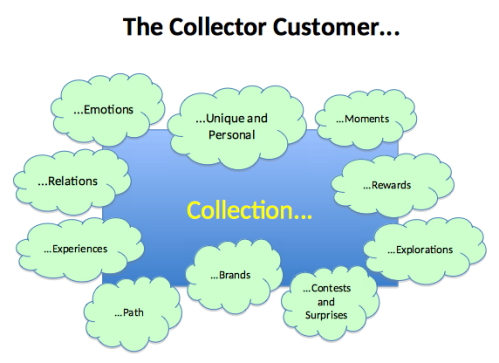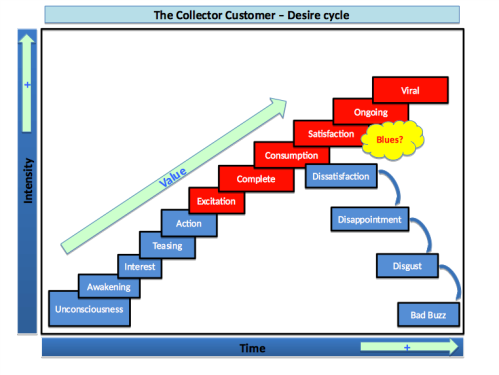The customer is still king. And even more. Complicated, inflexible, more informed than ever and genuine expert, he asks for more ongoing accuracy, kind of non stop learning. Ubiquity and always on stimulations have now, no limits. Traditional process for decision-making, from information to buying act never stops. Running for “always more”, faked in beliefs for “better”, endlessly with “never enough”.
We can closely say that there’s no goal anymore, no search for consumption but a path to trips, experiences and collection. Filling desires could be infinite through collection welfare, replacing uses, erasing the object, service and message.
The consumption flow
Consumption goes with life and maturity. From observer, fed by parents but more and more stimulated, and so earlier too. Big machine prepares our brains and our emotions. Desires are not natural anymore, but tricky and made of artificial and disguised lies to get stay aware. Marketing magic machine is here, to raise the envy, desire and stimuli, through real campaigns, enforcing our race for consumption. Build an artificial demand with unreasonable growth through a running consumption, blinded and fooling us. In the middle, the customer under the influence, actor of a movie he can’t handle, exploited by a dark architect: the brand.

From life cycle to live cycle…
We already heard about customer life cycle, drawing the raising level of customer, considering the value, for a brand. From profiled, to suspect to prospect and so long to old customer or real ambassador. A kind of clue track, between experiences, meetings and seduction phases. That life cycle describes the way a customer is valued for a brand, in economic terms, and so is precious to stick some resources and investments, balancing the global goals. This drives to a handsome ROI, at each phase of growth. But beyond economics, there’s another description on how customer grows with the brand: intensity. Intensity of desire, describing the physics of attention, awareness and needs, confronting the stimulation mecanism.
Modern profiling and data crunching identify potential customers even before they know themselves reveal their desire and match with the brand. Through affinity behaviors and algorithm buildind a « match » with a success rate. And that desire is often transformed in buying action. But, isn’t it the role of Marketing to build a story and trigger a need we don’t really have? The collector customer himself isn’t he fascinated by his own collection and then, by his desires, beyond all?

Every step needs a particular attention and specific means to optimize success to get through the next step. And each step contains everything from the former one and grows the desire in a tricky way, stimulating with relevant messages and methods. First in conception, the brand hopes for reaction to get stimulation and tease until please or disappoint. At that point, we can see limits as:
- no match between message and tools with desire step : the brand in rush goes too fast or disorganized, that creates a disappointment for the customer. No synchronisation in time, wastes effort
- is previous step understood? Any check to be sure that stimuli and emotion has been revealed?
- promotionnal urgency and sales can mix many emotions at the same time and burn the steps before they are assimilated, and then shake the needs ranking and rational process
- each customer is different: in his buying process and desire growth. The results on ROI go with it, and are various too. Get a fair appreciation from it makes efficient the next step and completes the fine-tuning
- don’t forget that we live in an “experiential” time, not obviously transactional. Patience is a wise weapon to get through to pass the hurdles. There’s so steps without reaction, not that it’s not working but there’s a mechanic inside in progress. Desire’s culture steps lead a relevant nursing…which trigger smart reactions and thenvalue the results. But the path is far more important than the result in itself, according to be reproduced and industrialized.
What about after collection?
…is so a delicate step: while collection is over, we can feel sometimes a kind of “blues” and sharp decrease of desire. Any collector is excited until he gets the last piece of his collection but then a whole “emptiness” perception is there throwing away desire. Excites, Thrills, Joy, Bliss…and nothing. The brand must go on, stimulating more and more any collector for his next collections. If not, brand will deceive and will get off collector’s mind. All the efforts for obsession’s pressure will be lost. That means a lot of money, programs and relation that will vanish in a snap. That’s why all the desire’s steps must be unveiled as an ongoing process. Anytime “sales” aren’t they a concrete way to sustain addiction and demand, even for needs we don’t have? Unfortunately, they’re only based on “price” with strong decrease of economic value for companies. And yes, there’s still many tricks to stimulate envy but price, if we just take the effort to listen, customize and invent them. A kind of sales innovation more scarce but terribly exciting. But also more differentiated and related, so less opened to copycat. Where you play on senses and emotions, you get attention and trustiness. And where there’s trust is where you succeed to set a balanced relation.
Well, having said and considered the attraction games between brands and customers, which role do we have to play where more and more consumers pay attention to decay or a more sense of growth? How will Brands will react to that slow motion, where everything is to reinvent?
Less is better (no « more », anymore…) ?


















